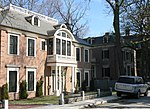Shady Hill Historic District
Cambridge, Massachusetts Registered Historic Place stubsHistoric districts in Middlesex County, MassachusettsHistoric districts on the National Register of Historic Places in MassachusettsNRHP infobox with nocatNational Register of Historic Places in Cambridge, Massachusetts

The Shady Hill Historic District is a historic district roughly bounded by Museum, Beacon and Holden, and Kirkland Streets, and Francis Avenue in Cambridge, Massachusetts. The district encompasses a residential area that is one of the city's most homogeneous neighborhoods of the second half of the 19th century. Located just east of the Harvard University campus, the area is characterized by large lot sizes and winding roads, with mature trees providing shade. The houses in the district are predominantly Queen Anne and Colonial Revival in character.The district was added to the National Register of Historic Places in 1986.
Excerpt from the Wikipedia article Shady Hill Historic District (License: CC BY-SA 3.0, Authors, Images).Shady Hill Historic District
Irving Street, Cambridge
Geographical coordinates (GPS) Address Nearby Places Show on map
Geographical coordinates (GPS)
| Latitude | Longitude |
|---|---|
| N 42.379166666667 ° | E -71.111388888889 ° |
Address
Irving Street 107
02143 Cambridge
Massachusetts, United States
Open on Google Maps









